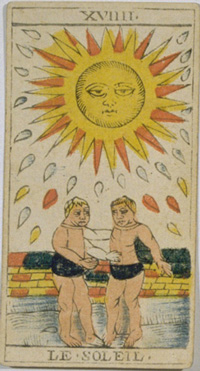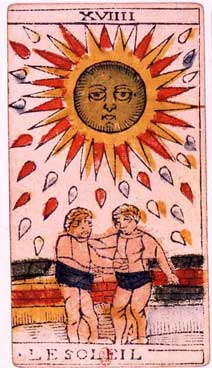
The Tarot of Jean Dodal
originals (Paris c. 1701) preserved in the French National Library and restoration

Graphically. the Tarot of Jean Dodal (Lyon) and Jean Payen (Avignon) resemble each other so much that one risks confusing them. I draw therefore a simple conclusion: the same engraving workshop is responsible these two early-18th century Tarots.
One must always make a distinction between engravers and “cartiers” or card-makers, the latter being in general only editors and image merchants.
The engraver of the Jean Dodal and Jean-Pierre Payen Tarots hasn’t the high level of graphic talent and sure touch of Conver, nor the virile mastery of Noblet. What most characterises his work is its touching, uncomplicated quality. Dodal’s engraver is a simple person, surely well-rooted in a popular environment, direct. He is not intellectual or sophisticated.

Payen

Dodal
Dodal indulges in no trickery or double meanings with his images. He had certainly been apprenticed with a master who was able to transmit whatever teachings and traditions were still extant at the end of the 17th century. The Dodal tarot dates from 1701-1715, the Payen from 1713. This engraver was still aware of the inner meaning of the Tarot. His work has a pleasant freshness, naivety and candour of line. And what is more, he is learned!
Some significant details can be observed in this Tarot only, while others are common to most historic Tarots. The young woman of XVII THE STAR is pregnant and is seen both from the front and in profile. The flames in XVI THE HOUSE OF GOD go upwards. The angel of VI The LOVERS is blindfolded. XIV TEMPERANCE is bare-breasted. One of the children in XVIIII THE SUN is blind, XII THE HANGED MAN has strange hands…
However, we are already in the 18th century, and even if XV THE DEVIL retains the traditional face on his stomach and eyes on his knees, superstition and propriety impose that XIII DEATH is no longer named and the FOOL has his bottom clothed.
This second face on the Devil’s belly brings to mind the instruction in the fraternities concerning the “sense” of a stone. Whether it”attracts” or “repels” the mason’s belly indicates the stone’s intrinsic orientation. To build in the sacred mode, this sense must be taken into account. This second face systematically suggests this method of “looking” at stone. As for the eyes on the knees, one must think of the Jesuits’ diminutive for the knees: the “little head”.
To observe these details and compare the restoration with the originals, here are the major arcana of the Jean Dodal Tarot:

